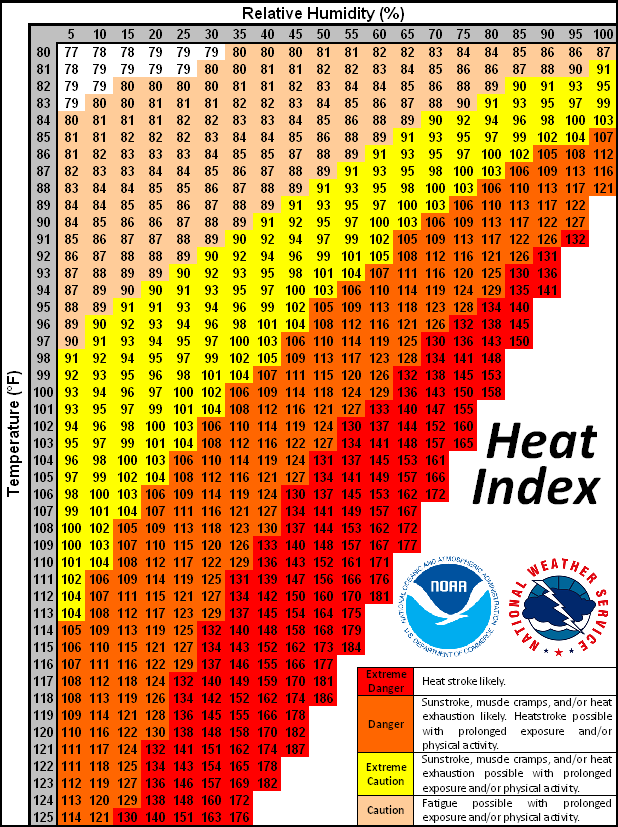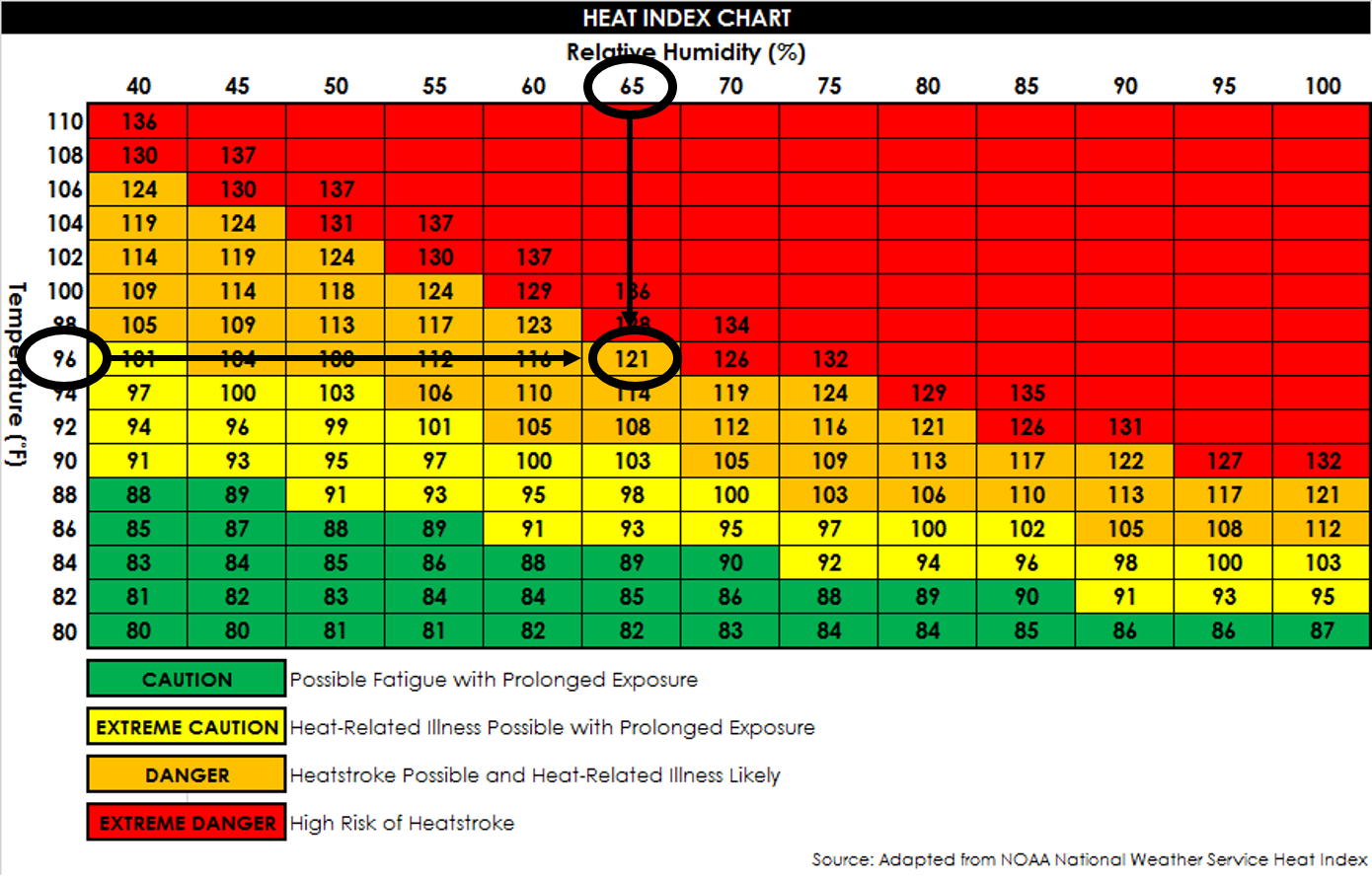It’s so important to know the Heat Index, so you can keep yourself safe and informed in various weather styles. The Heat Index is the temperature that it feels like when the heat and humidity combine. Here’s a helpful chart to help you keep track of and understand the Heat Index.
National Weather Service Heat Index Chart
 Uncomfortably hot weather can be dangerous if precautions aren’t taken. Taking simple measures like staying indoors and drinking plenty of fluids can make all the difference in staying safe in the heat. Heat gain can increase body temperature, resulting in heat-related illnesses such as heat stroke. People preparing to exercise outdoors or working in the heat may need to modify their hot-weather activities when the Heat Index is high.
Uncomfortably hot weather can be dangerous if precautions aren’t taken. Taking simple measures like staying indoors and drinking plenty of fluids can make all the difference in staying safe in the heat. Heat gain can increase body temperature, resulting in heat-related illnesses such as heat stroke. People preparing to exercise outdoors or working in the heat may need to modify their hot-weather activities when the Heat Index is high.
The heat index - Arizona’s Family
 When the Heat Index is over 100° F, precautions should be taken to work or exercise outdoors. Some of these precautions include wearing light-colored and lightweight clothing, taking frequent breaks in the shade or indoors, avoiding direct sun exposure and drinking plenty of fluids, preferably water. Keep in mind, it is important to recognize the signs and symptoms of heat-related illnesses and to respond immediately by cooling down and seeking medical attention if needed.
When the Heat Index is over 100° F, precautions should be taken to work or exercise outdoors. Some of these precautions include wearing light-colored and lightweight clothing, taking frequent breaks in the shade or indoors, avoiding direct sun exposure and drinking plenty of fluids, preferably water. Keep in mind, it is important to recognize the signs and symptoms of heat-related illnesses and to respond immediately by cooling down and seeking medical attention if needed.
Heat Stress Monitoring - OHSA Occupational Health Services Australia
 It is important to recognize the signs and symptoms of heat-related illnesses and to respond immediately by cooling down and seeking medical attention if needed. When experiencing extreme heat and high humidity, be sure to take the necessary precautions to prevent getting sick. Some of the signs and symptoms to be aware of include headaches, nausea, and dizziness. If you experience any of these symptoms, it is important to get to a cool place, drink plenty of fluids, and seek medical care if necessary.
It is important to recognize the signs and symptoms of heat-related illnesses and to respond immediately by cooling down and seeking medical attention if needed. When experiencing extreme heat and high humidity, be sure to take the necessary precautions to prevent getting sick. Some of the signs and symptoms to be aware of include headaches, nausea, and dizziness. If you experience any of these symptoms, it is important to get to a cool place, drink plenty of fluids, and seek medical care if necessary.
Understanding Heat Index | WOAI
 Heat-related illnesses occur when your body can not properly cool itself due to exposure to extreme temperatures and high humidity. To prevent heat exhaustion, heat stroke, and other serious illness, it is important to take the necessary precautions when outdoors in the heat. Some tips for staying safe in the heat include drinking plenty of fluids, taking frequent breaks in a shaded or air conditioned area, wearing lightweight clothing, and limiting activity to early morning or evening hours.
Heat-related illnesses occur when your body can not properly cool itself due to exposure to extreme temperatures and high humidity. To prevent heat exhaustion, heat stroke, and other serious illness, it is important to take the necessary precautions when outdoors in the heat. Some tips for staying safe in the heat include drinking plenty of fluids, taking frequent breaks in a shaded or air conditioned area, wearing lightweight clothing, and limiting activity to early morning or evening hours.
Beat the Heat: Identifying and Preventing Heat Stress
 Heat exhaustion can occur when the body can not cool itself efficiently. To avoid heat exhaustion, be sure to stay inside in air conditioned areas, drink plenty of fluids, and wear loose-fitting clothing. If symptoms of heat exhaustion such as extreme fatigue, nausea, and weakness occur, stay out of the sun and seek medical attention if needed.
Heat exhaustion can occur when the body can not cool itself efficiently. To avoid heat exhaustion, be sure to stay inside in air conditioned areas, drink plenty of fluids, and wear loose-fitting clothing. If symptoms of heat exhaustion such as extreme fatigue, nausea, and weakness occur, stay out of the sun and seek medical attention if needed.
Do You Know Today’s Heat Index? - LHSFNA
Heat stroke is an extremely dangerous condition that occurs when the body can no longer cool itself resulting in both mental and